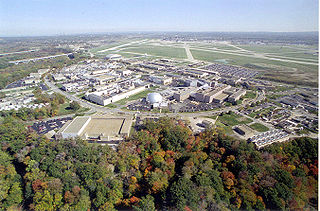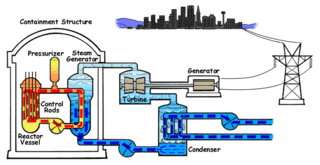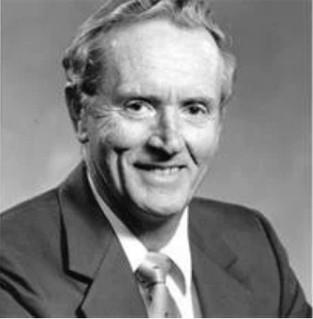
A nuclear thermal rocket (NTR) is a type of thermal rocket where the heat from a nuclear reaction, often nuclear fission, replaces the chemical energy of the propellants in a chemical rocket. In an NTR, a working fluid, usually liquid hydrogen, is heated to a high temperature in a nuclear reactor and then expands through a rocket nozzle to create thrust. The external nuclear heat source theoretically allows a higher effective exhaust velocity and is expected to double or triple payload capacity compared to chemical propellants that store energy internally.
A nuclear electric rocket is a type of spacecraft propulsion system where thermal energy from a nuclear reactor is converted to electrical energy, which is used to drive an ion thruster or other electrical spacecraft propulsion technology. The nuclear electric rocket terminology is slightly inconsistent, as technically the "rocket" part of the propulsion system is non-nuclear and could also be driven by solar panels. This is in contrast with a nuclear thermal rocket, which directly uses reactor heat to add energy to a working fluid, which is then expelled out of a rocket nozzle.

William Alison Anders is a retired United States Air Force (USAF) major general, former electrical engineer, nuclear engineer, NASA astronaut, and businessman. In December 1968, he was a member of the crew of Apollo 8, the first three people to leave low Earth orbit and travel to the Moon. Along with fellow astronauts Frank Borman and Jim Lovell, Anders circled the Moon ten times, and broadcast live images and commentary back to Earth. During one of the mission's lunar orbits, he took the iconic Earthrise photograph.

The National Advisory Committee for Aeronautics (NACA) was a United States federal agency founded on March 3, 1915, to undertake, promote, and institutionalize aeronautical research. On October 1, 1958, the agency was dissolved and its assets and personnel were transferred to the newly created National Aeronautics and Space Administration (NASA). NACA is an initialism, i.e., pronounced as individual letters, rather than as a whole word.

NASA John H. Glenn Research Center at Lewis Field is a NASA center within the cities of Brook Park and Cleveland between Cleveland Hopkins International Airport and the Rocky River Reservation of Cleveland Metroparks, with a subsidiary facility in Sandusky, Ohio. Its director is James A. Kenyon. Glenn Research Center is one of ten major NASA facilities, whose primary mission is to develop science and technology for use in aeronautics and space. As of May 2012, it employed about 1,650 civil servants and 1,850 support contractors on or near its site.

Nuclear propulsion includes a wide variety of propulsion methods that use some form of nuclear reaction as their primary power source. The idea of using nuclear material for propulsion dates back to the beginning of the 20th century. In 1903 it was hypothesized that radioactive material, radium, might be a suitable fuel for engines to propel cars, planes, and boats. H. G. Wells picked up this idea in his 1914 fiction work The World Set Free. Many aircraft carriers and submarines currently use uranium fueled nuclear reactors that can provide propulsion for long periods without refueling. There are also applications in the space sector with nuclear thermal and nuclear electric engines which could be more efficient than conventional rocket engines.

Project Prometheus was established in 2003 by NASA to develop nuclear-powered systems for long-duration space missions. This was NASA's first serious foray into nuclear spacecraft propulsion since the cancellation of the SNTP project in 1995. The project was planned to design, develop, and fly multiple deep space missions to the outer planets.

The Nuclear Engine for Rocket Vehicle Application was a nuclear thermal rocket engine development program that ran for roughly two decades. Its principal objective was to "establish a technology base for nuclear rocket engine systems to be utilized in the design and development of propulsion systems for space mission application". It was a joint effort of the Atomic Energy Commission (AEC) and the National Aeronautics and Space Administration (NASA), and was managed by the Space Nuclear Propulsion Office (SNPO) until the program ended in January 1973. SNPO was led by NASA's Harold Finger and AEC's Milton Klein.

Annie Jean Easley was an American computer scientist, mathematician, and rocket scientist. She worked for the Lewis Research Center of the National Aeronautics and Space Administration (NASA) and its predecessor, the National Advisory Committee for Aeronautics (NACA). She was a leading member of the team which developed software for the Centaur rocket stage, and was one of the first African-Americans to work at NASA. Easley was posthumously inducted into the Glenn Research Hall of Fame in 2015. On February 1, 2021, a crater on the Moon was named after Easley by the IAU.

Abraham "Abe" Silverstein was an American engineer who played an important part in the United States space program. He was a longtime manager at the National Aeronautics and Space Administration (NASA) and its predecessor, the National Advisory Committee for Aeronautics (NACA). He was instrumental in the planning of the Apollo, Ranger, Mariner, Surveyor, and Voyager missions, and named the Apollo program after the Greek and Roman God.
Harold R. Kaufman was an American physicist, noted for his development of electrostatic ion thrusters for NASA during the 1950s and 1960s. Kaufman developed a compact ion source based on electron bombardment, the "Kaufman Ion Source," a variant of the duoplasmatron, for the purpose of spacecraft propulsion.

Spacecraft electric propulsion is a type of spacecraft propulsion technique that uses electrostatic or electromagnetic fields to accelerate mass to high speed and thus generate thrust to modify the velocity of a spacecraft in orbit. The propulsion system is controlled by power electronics.
Gary L. Bennett is an American scientist and engineer, specializing in aerospace and energy. He has worked for NASA and the US Department of Energy (DOE) on advanced space power systems and advanced space propulsion systems. His professional career has included work on the Voyager, Galileo, and Ulysses space missions, and is currently working as a consultant in aerospace power and propulsion systems. He is also a science fiction author.

Project Rover was a United States project to develop a nuclear-thermal rocket that ran from 1955 to 1973 at the Los Alamos Scientific Laboratory (LASL). It began as a United States Air Force project to develop a nuclear-powered upper stage for an intercontinental ballistic missile (ICBM). The project was transferred to NASA in 1958 after the Sputnik crisis triggered the Space Race. It was managed by the Space Nuclear Propulsion Office (SNPO), a joint agency of the Atomic Energy Commission (AEC), and NASA. Project Rover became part of NASA's Nuclear Engine for Rocket Vehicle Application (NERVA) project and henceforth dealt with the research into nuclear rocket reactor design, while NERVA involved the overall development and deployment of nuclear rocket engines, and the planning for space missions.
The United States Space Nuclear Propulsion Office (SNPO) was a US government agency created in 1961 in response to NASA Marshall Space Flight Center's desire to explore the use of nuclear thermal rockets created by Project Rover in NASA space exploration activities.

The National Aeronautics and Space Administration (NASA) was created in 1958 from the National Advisory Committee for Aeronautics (NACA), and other related organizations, as the result of the Space Race between the United States and the Soviet Union in the 1950s.
There are NASA facilities across the United States and around the world. NASA Headquarters in Washington, DC provides overall guidance and political leadership to the agency. There are 10 NASA field centers, which provide leadership for and execution of NASA's work. All other facilities fall under the leadership of at least one of these field centers. Some facilities serve more than one application for historic or administrative reasons. NASA has used or supported various observatories and telescopes, and an example of this is the NASA Infrared Telescope Facility. In 2013 a NASA Office of the Inspector General's (OIG) Report recommended a Base Realignment and Closure Commission (BRAC) style organization to consolidate NASA's little used facilities. The OIG determined at least 33 of NASA's 155 facilities were underutilized.

Milton Klein was an American nuclear engineer who was the head of the United States nuclear rocket program. He helped establish and lead the Space Nuclear Propulsion Office, a liaison organization between NASA and the Atomic Energy Commission to coordinate efforts to create a nuclear thermal rocket.

William H. (Red) Robbins was an American engineer who worked for the National Aeronautics and Space Administration (NASA). During his long career at NASA, he worked on the NERVA nuclear rocket engine, NASA wind turbines, communication satellites, and the Shuttle-Centaur program. He accepted an Emmy Award in September 1987 on behalf of NASA for the contributions of satellite communications to the television industry.

Frank Ernest Rom Sr. was an engineer who worked for the National Advisory Committee for Aeronautics (NACA) and it successor, the National Air and Space Administration (NASA). He wrote many papers on the uses of nuclear propulsion for rockets for interplanetary travel. In the 1970s, he was involved in NASA's exploration of solar, wind and tidal energy sources as alternative to fossil fuels, and found his own solar energy company, Rom-Aire Solar Energy Products, based on his patents for air-based solar heating and collecting systems.















